Conditions and care
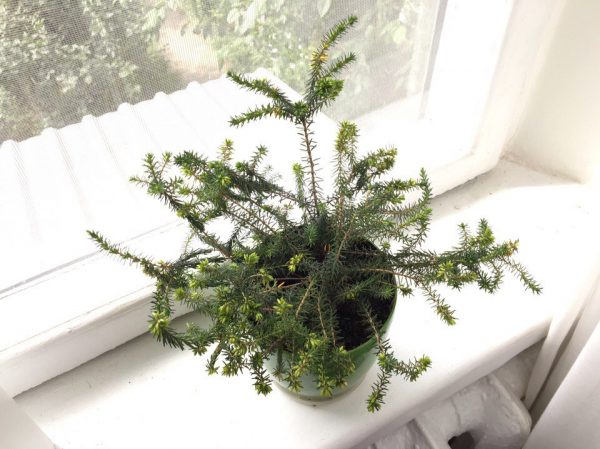
At home, cryptomeria grows in the mountains, where it is not too hot. In dense thickets, diffused light predominates and moisture is well preserved. It is these conditions that it is desirable to create a grower for home cryptomeria, so that the plant feels comfortable.
Location and lighting
The main trouble with room cryptomeria, with its incorrect location, is the burning of needles in direct sunlight. She needs a lot of light, but not direct, but diffused.
These conditions are met by windows facing west and east. Cryptomeria feels good against the wall between the two southern windows. It is believed that the plant tolerates partial shade, but the peak of decorativeness can be achieved only with full lighting.
Temperature
Cryptomeria is a southerner, but that doesn't mean she'll be fine in the heat. In the mountains, where the natural range is located, high temperatures are a rare phenomenon. Even in summer, the plant needs moderate heat - from 18 to 22 degrees. Infrequent fluctuations in one direction or another within small limits will not harm cryptomeria. But if in winter the temperature is not reduced to + 6-12 degrees, the well-being of the ephedra will suffer tangible damage up to its death.
The best place for wintering is a bright glazed loggia without direct sunlight. In the summer, you can bring cryptomeria to your garden and place it in the lacy shade of trees.
Air humidity
Home cryptomeria successfully exists only when the air humidity is from 60 to 80%, which usually does not happen in a city apartment. We have to increase it artificially:
- spray the plant twice a day with soft warm water;
- install a humidifier next to it;
- place a pot of cryptomeria on a pallet of damp moss or pebbles.
- Do not place ephedra near a heat source.
The air around cryptomeria should be not only humid, but also fresh, frequent ventilation is encouraged, but without drafts.
The soil
The substrate for cryptomeria must be fertile, it must pass and retain moisture well, and not impede the passage of air to the roots. For its preparation, take in equal parts sod land, sand and well-ripened peat.
Cryptomeria is acidophilus. The soil pH value for it should be in the range of 5-6.
The addition of coniferous soil - rotted coniferous litter - will help acidify the substrate. Its amount is determined by acidity indicators.
Watering
Cryptomeria loves water, but fanaticism when watering is inappropriate.
For this plant, the golden mean is suitable - always moderately moist soil.
The frequency of watering cryptomeria depends on many conditions: the temperature of the substrate in the pot and the ambient air, the time of year, the conditions of keeping - in the garden or at home. In winter, it is required to moisten the ephedra less - about 4 times a month, in summer - as the top layer of the soil dries slightly. The water temperature is the same as that of the air surrounding the plant; the presence of calcium salts is not allowed in it. They alkalize the soil, which is unfavorable for the development of ephedra.
Top dressing
For cryptomeria, two feedings per season of active growth are enough. It should take 2 months from transferring to a new pot to the first of them. Mineral fertilizers are used for conifers, the concentration during cultivation is halved against the norm in the instructions.
Transfer
Caring for cryptomeria at home implies its periodic transplant. But it should be annual only for young plants. For a tree over 5 years old, it is enough to replace the upper part of the soil (5 cm). This should be done annually.
An adult ephedra is transplanted no more often than once every 4 years in early spring.
The plant suffers damage to the root system very painfully, so it is simply transferred into a new pot, completely preserving the earthen lump. The number of sprays then increases.
When preparing the plant for transplantation, drainage is arranged in a new pot.
The subtleties of cultivation in the garden
Cryptomeria looks spectacular in landscape gardening. The main thing is to choose a suitable site for an evergreen tree: with a sufficient level of illumination, without through winds and with slightly acidic soil, moderately moist. Soil with a high content of limestone or close occurrence of waters is contraindicated for a plant.
Watering the Japanese cedar is needed especially plentiful in the spring-summer period, in winter the frequency and quantity should be reduced
It is important to pay attention to the condition of the needles: if it has changed its color to yellow, then this indicates a lack of moisture in the soil. Spraying the crown has a beneficial effect on the tree, up to twice a day. Sprinkling must be done in summer
Sprinkling should be done in the summer.
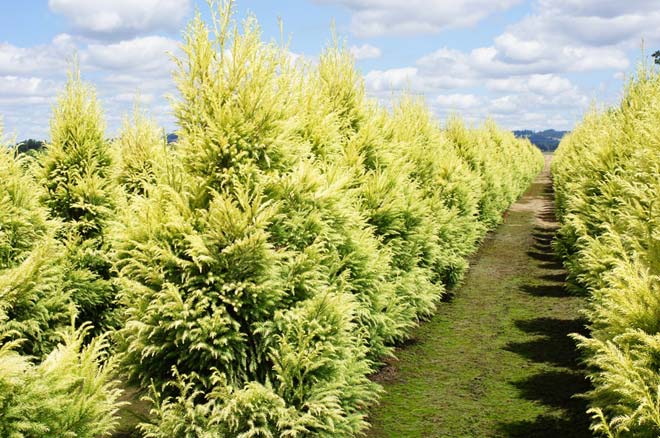
The feeding procedure is performed every spring, using mineral or organic compounds for these purposes. If it was noticed that the growth of the tree has slowed down, then the nutrient mixture is added in the fall. Young trees do not feed in the first two months, they apply fertilizer every spring.
Japanese cryptomeria is rightfully an amazing exotic plant with a gorgeous crown shape. It is grown both at home and in the garden. The main thing is to choose the right variety for the specific growing conditions and provide it with proper care. Then a beautiful evergreen tree will delight you for more than one year.
Many gardeners dream of getting a beautiful one that will be unpretentious to care for and can grow at home. Especially pleasing to the eye, but most of them are very difficult to grow at home.
One of such attractive and evergreen trees is.In this article, we will consider what cryptomeria is and what care is needed for it at home.
Varieties and photos
Below are descriptions and photos of varieties of Japanese Cryptomeria, suitable for reproduction and care at home.
Spiralis (Cryptomeria Spiralis)
It grows in the form of a bush with drooping and very long branches. Spirally twisted needles, curved and thick, grow on the branches. With age, the plant has a full-fledged kegle-shaped trunk, around which branches are lit up, and the needles change color. The photo below shows the Cryptomeria of Spiralis:
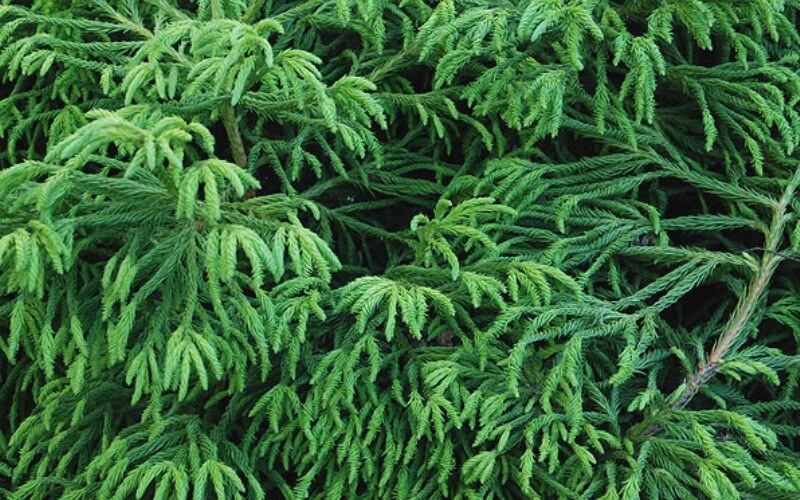
Gold (Cryptomeria Vilmorin Gold)
The fruit of many years and hard work of breeders. Often planted to decorate plots, since its shoots have a delicate golden yellow color. Does not differ in frost resistance. What the Cryptomeria Zolotistaya variety looks like can be seen in the photo below:

Elegans (Cryptomeria Elegans compacta)
One of the slowest growing varieties. It is a tree up to 2 meters high (it is extremely rare to reach 10 meters). The needles in winter are burgundy-bronze or green-purple, while in summer they acquire brown shades. Cones only grow on young plants. The variety is resistant to drought and other adverse factors. Average frost resistance: young, recently planted plants can freeze slightly, so you need to select a place protected from the wind and cover the first winters.
He was awarded for high decorativeness by the Royal Horticultural Society of Great Britain. In the photo below, the Cryptomeria Elegance variety:
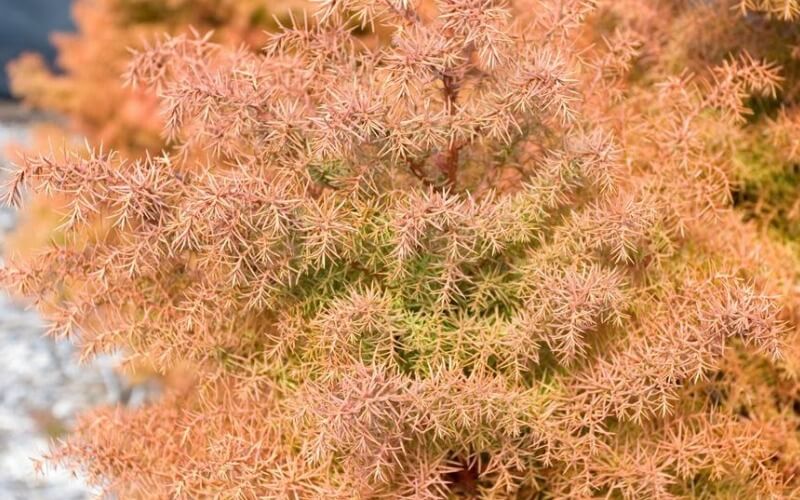
However, it is necessary to choose the right varieties: in natural conditions, trees grow up to 60 meters in height, and the trunk girth can be 2 or more meters. Japanese cryptomeria became widespread in the middle of the 19th century, and many varieties were gradually developed for cultivation and care both in greenhouses and at home.
Care features
Before deciding to plant cryptomeria, it is important to understand that this exotic tree is more demanding than other conifers typical for our area. The culture is very thermophilic and photophilous, but does not tolerate excessive heat
The best conditions will be a sunny location, sheltered from the wind. Heat-loving species can be grown in deep pots and brought into a cool and bright room for the winter.
The culture is very thermophilic and photophilous, but it does not tolerate excessive heat. The best conditions will be a sunny location, sheltered from the wind. Heat-loving species can be grown in deep pots and brought into a cool and bright room for the winter.
The tree grows well in fertile, moderately moist, acidic soil with good water permeability. Stagnant water causes the development of root rot. Japanese cedar is intolerant to poor, cold substrates and dry climate.
When planting Japanese Cryptomeria, it is useful to add compost or manure to the garden soil. Sand is added to heavy clay in a 1: 1 ratio and a good drainage layer is poured from broken brick or large expanded clay. Sandy soils are mixed with compost or peat moss.
Outdoor care for azalea
To maintain soil moisture and protect it from frost in winter, the soil around the trunk area is mulched with peat or pine bark. When mulch decomposes, it enriches the soil with nutrients.
From spring to autumn, cryptomeria must be watered regularly and abundantly, carefully watching so that the water does not stagnate. This is especially true when growing a plant in a pot.

Air humidity is also important for this coniferous beauty, so constant spraying in dry and hot weather will also be useful (ideally, twice a day). Yellowing and falling of needles is a sure sign of a lack of moisture in the air or soil.
It is also recommended to feed the seedlings with decaying organic matter once every two weeks, and adult specimens - once a month. Top dressing is carried out from spring to autumn, taking a break in July.
Reproduction
Cryptomeria is propagated by non-lignified cuttings, seeds or layering. When grafting, young shoots are cut with a sharp knife and lowered for rooting in a container of water. For active root formation, treatment of the sections with heteroauxin is desirable.
When the roots appear, the cutting is planted in a mixture of turf, leafy soil and coarse river sand. In the second case, fresh seeds are sent to a mixture of perlite and peat, taken in equal proportions.
In order not to disturb the root system during thinning in the future, sowing is best done immediately in separate containers, one seed at a time.
Types and preparation of garden compost
When propagating by layering, the flexible lower branch is bent to the ground and sprinkled with soil mixed with compost a little, leaving only the top outside. Frequent watering.
After about 2-3 months, the cuttings will take root, start their own shoots and be able to grow separately from the mother plant. Rooted seedlings, cuttings and cuttings grow and bush quickly, so you can start forming the crown already on a small tree.
Application in garden design
Although cryptomeria requires slightly more maintenance than other garden dwellers, growing this crop is well worth the effort.
Japanese cedar unobtrusively introduces exotic oriental notes into landscape design, creates unique compositions with heuchera, coleus, Thunberg barberry, Japanese spirea, euonymus, and other representatives of low conifers.
The plant is ideal for creating rockeries, alpine slides, dwarf varieties are planted in groups along paths or fences.
Diseases and pests
If the needles of cryptomeria darken or turn yellow, and the shoots die off, the cause is a fungal infection. You cannot hesitate with treatment:
- they revise the roots, for which the plant is taken out of the pot, all the blackened ones are cut off, the cuts are covered with crushed coal or colloidal sulfur;
- the ephedra is planted in a disinfected container, disinfecting the soil;
- water the soil with a solution of phytosporin (dilute according to the instructions), they also spray the green parts of the plant and the trunk;
- processing must be repeated weekly up to 5 times.
Pests are not overly fond of cryptomeria. They are scared off by phytoncides secreted by the tree. Sometimes a mealybug settles on it, similar to tiny pieces of cotton wool. Treatment with a solution of "Fozolon" 0.2% concentration will help.
How to care for room cryptomeria

Location features and illumination
As mentioned above, this plant is quite photophilous, but it should be noted that when grown at home, it must be protected from direct sunlight. This evergreen conifer can be grown and placed in partial shade. But it's still better if it receives enough light. In the event that the plant is not very large, then the pot with it can be installed in the walls between 2 windows.
Temperature regime
In the summertime, the tree is best taken outside. But if this is not possible, then at room temperature it will feel quite acceptable. It is worth considering that the room in which cryptomeria is located must be ventilated very often, since it reacts extremely negatively to stagnant air. Regular ventilation should be carried out both in summer and winter.
In winter, it is necessary to ensure that the room where this conifer is located is not higher than 12 degrees, since the high temperature is contraindicated for it at this time.
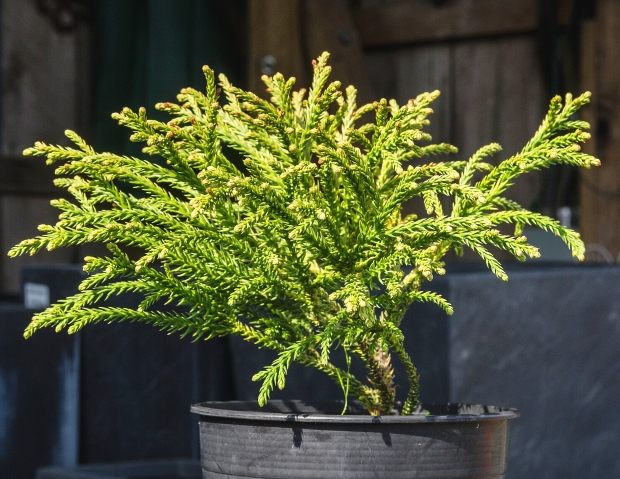
How to properly water and feed
Watering should not be too frequent. In general, you should stick to the middle ground. So, the earthen lump should in no case dry out. But you should also not allow stagnation of water in the soil. Otherwise, rotting of the root system may begin, and as a result, cryptomeria will die. In this regard, during transplantation or planting of this plant, it is imperative to take care of drainage.
This tree needs frequent spraying. It must be carried out at least twice a day, and preferably more times. If this is neglected, then the needles will begin to turn yellow and fall off. Watering and moistening the plant is necessary with plain water, but it must be warm (20-25 degrees).
Cryptomeria should be fed only a couple of times a year and in the summer months. For this, mineral fertilizers are used, diluting ½ part of the recommended dosage in water.
Transplant features

In the first few years of life, this ephedra is transplanted annually. However, it should be borne in mind that you should not do this without special need.
Transplant this plant with extreme caution. The thing is that if this procedure is carried out regularly and you take a pot even a little larger than the previous one, then because of this, a very intensive growth of cryptomeria can begin.
The same result can be achieved with rare transplants, in the event that the pot is much larger than the previous one. As a result, instead of a beautiful and neat dwarf ephedra, you will grow a huge tree.
Of course, the tree grows, and sooner or later there comes a time when a transplant is simply necessary for him.
It is important to consider here that this procedure must be carried out very carefully, and it would even be better to limit it to transshipment. This ephedra has a very sensitive root system and it is better not to disturb it unnecessarily.
In spring, in adult cryptomeria, only a change in the upper layer of the earth is made.
Reproduction of cryptomeria

You can grow this tree, if desired, from a cuttings or seeds. The second method is quite complicated and is suitable only for experienced florists, as well as breeders. It is best to use the first method for reproduction. To do this, you will need to cut off a non-lignified stalk and put it in a glass of water.It can be pretreated with a preparation that stimulates root growth. After the roots appear, the cutting should be planted in a prepared pot with soil (leafy earth + sand + turf soil taken in a ratio of 1: 1: 1). If everything is done correctly, then soon the young cryptomeria will take root and begin to grow.
Home care for a houseplant
Cryptomeria is undemanding in content. The main thing is to follow certain rules of care.
Lighting
Cryptomeria is referred to as light-loving plants. Indoors, they are kept on the western and eastern windowsills. On the south side, at noon, the plant must be shaded from direct sunlight. And when growing on northern windows, additional lighting is installed in the form of phytolamps.
In the summer, the pot with the plant is taken out into the garden, but a place is chosen where the sun's rays fall only in the afternoon.
Temperature regime
In the spring and summer, the optimum temperature is 22-25 degrees. In the winter season, the thermometer mark should be at 12 degrees.
Watering

Therefore, water the plant sparingly, as the top layer of the soil dries up. During cold wintering, the number and frequency of watering is reduced.
Water is used filtered or settled.
Cryptomeria requires increased air humidity. For this, the crown of the plant is regularly sprayed with water (1-2 times a day).
They put the pot on a pallet with wet expanded clay, and also install a container with water next to it.
Fertilizer
The plant is fed only 2 times a year, in early spring and summer, since excessive fertilization can lead to very intensive growth.
After planting, young plants are not fed for a couple of months, and then 2 fertilizing is carried out with a frequency of 1 month.
Planting and transplanting
Young specimens are transplanted annually until they reach 5 years old. After that, the procedure is carried out once every 4 years. Frequent transplanting can lead to rapid growth and from a compact plant, cryptomeria will turn into a real tree. The pot is purchased a little more than the previous one. The soil is used universal for indoor plants or made independently, for this they mix in equal proportions: turf, leafy soil, peat and sand.
The transplant process consists of the following steps:
- A drainage layer of expanded clay or pebbles is laid at the bottom of the pot.
- Pour a little into a container of prepared soil.
- Carefully take out the plant and, together with an earthen lump, set it in the middle of the flowerpot.
- The voids are filled with soil and watered abundantly.
Old plants are not transplanted, they only renew the top layer of the soil substrate.
Reproduction
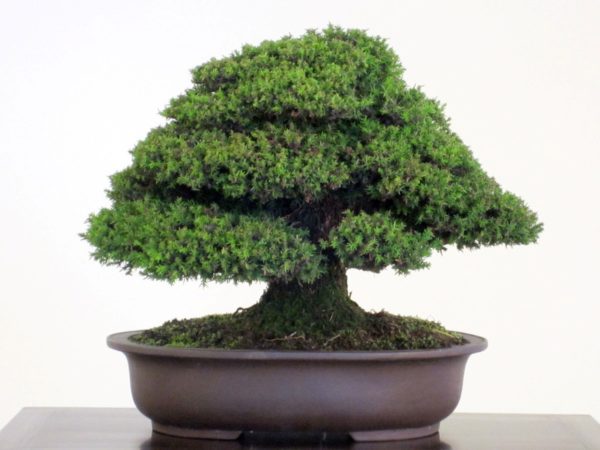
Cryptomeria can be propagated at home just like other plants. There are several ways to do this:
- Seeds. The procedure is carried out in early spring. A drainage layer is placed in a plastic container, on top of a wet mixture of sand and peat in a 1: 1 ratio. Then the seed is distributed at a distance of 3-5 cm from each other. Not deepening much. Cover with foil on top. They are kept under diffused lighting, periodically moistened and ventilated. After 2-3 weeks, young shoots appear, which are eventually transplanted to a permanent place.
- Cuttings. At the end of August, cuttings are cut off from non-lignified shoots. The needles are cleaned from their lower part, placed in a growth stimulant solution, and then in water. After the roots appear, the plant is transplanted into permanent soil. Placed in a room with diffused light.
- Layers. In early spring, the lower shoot is exposed, 1-2 cuts are made and bent to the ground. Fix it with a bracket and sprinkle it with earth. The top is left open. After a while, new shoots appear, which are separated from the mother tree and transplanted into separate containers.
There is nothing difficult in the breeding process, the main thing is to choose the most suitable method for yourself.
Garden forms of cryptomeria

Kliptomeria is widespread throughout the world and has about two hundred species. In this large family, all monoecious plants have an unusual and remarkable shape. To some, this ephedra resembles an elegant pyramid, and to someone - a sports skittle. All species of this evergreen like to grow in acidic and moist soils. They feel great in well-lit and sunny areas, they are unpretentious in care.
Elegans - This breed belongs to a slow-growing species. She has fully adapted to urban conditions and different climates. This species is not only frost-resistant, but also able to grow in arid conditions. He is not afraid of city dust and smoke. Almost nothing can affect its decorative qualities and development. This type of tree can even be planted in partial shade areas.
Throughout the year, the color of the needles pleases with different colors. In summer, it turns brown-green, and in winter, coniferous branches delight the eye with green-purple and bronze-red tints.
Vilmoriniana is a dwarf breed. This type is often preferred by gardeners, since the plant does not take up much space on the site, but decorates it perfectly. In winter, the decorative qualities of the plant are especially noticeable. The reddish-lilac shade of the needles stands out from the rest of the plants. This short beauty grows no more than four centimeters in height during the year.
The Bandai-sugi is a breed familiar to European gardeners and landscape designers. Such dwarf trees have sprawling coniferous branches of a bluish-green hue.
"Golden" - this breed is often used as a decoration of the site. Young shoots of this species are a real decoration, as they have a golden yellow color.
Among the large number of breeds, there are those most adapted to the cold climate, especially winter-hardy species - Globosa nana, Lobbi, Jindai sugi.
Sciadopitis verticulata
 Sciadopitis verticulata: general view and escape
Sciadopitis verticulata: general view and escape
In my desktop encyclopedia in relation to sciadopitis, it is indicated that it belongs to two families - Sciadopitis / Taxodia. He comes from southern Japan. The needles are dark green, 5-12 cm long, collected in whorls at the ends of the shoots, preserved for 4 years. Cones (female) are ovoid, single, 5-8 cm long, male cones are collected in apical capitate formations.
Features of growing in the open field
 Sciadopitis verticulata is ready for planting in a permanent place, after planting chlorositis
Sciadopitis verticulata is ready for planting in a permanent place, after planting chlorositis
Reaches normal development in shaded areas of southern dachas with deep fertile drained soils. Propagated by seeds. Saplings up to 3-5 years old are grown in containers.
It is interesting:
In fact, sciadopitis does not have needles, but phylloclades - modified leaves.
Transplant of room cryptomeria
It is advisable not to transplant garden cryptomeria, choose a suitable place for it right away.
When grown in a tub or flowerpot, the plant must be transplanted every spring for the first 2-3 years of life. This is done mainly for the purpose of updating the substrate. If you transplant cryptomeria regularly and at the same time take an even slightly larger container, it will "grow" into a giant. The result will be the same as when planting in a large pot. Therefore, with each transplant, the capacity should only be slightly larger than the size of the earthen coma.
Be careful with the root system, use the transshipment method.
Mature plants are transplanted about once every 5 years. Replace the top layer of the substrate with a new one annually in the spring.
Remove it carefully so as not to damage the roots.
Prepare the soil mixture from equal proportions of leaf, turf, peat and sand. At the bottom we lay a drainage layer with a thickness of ¼ of the total volume of the container. Expanded clay, pebbles, small stones, broken brick will be used as drainage.
Do-it-yourself cedar bonsai cultivation
Soil and Pot:
Almost all varieties of cedar bonsai, except Atlas, begin active new growth in early spring.Atlas Cedars prefer warmer weather for transplanting and usually stay dormant until late spring. Cedar bonsai prefers slightly more organic matter than most other conifers.
Due to active growth during a fairly short growing season. 65% Aggregate and 35% organic matter (fertilizer) is a good mix. The aggregate can be decomposed granite (preferred is that they grow in nature) or pumice, coarse sand. The best organic matter is compost bark. Atlas Cedars can handle a wide variety of fertilizers.
In the spring, an organic fertilizer with a high nitrogen content is needed to stimulate new growth.

Seat selection:
Prefers full sun, only Himalayan cedar bonsai prefer shade. Their needles turn pale in the sun and they will change to a darker and healthier blue when kept in the shade.
Pests and diseases:
Like their pine cousins, cedars are vulnerable to rotting, so don't keep them in high humidity areas and make sure they are in well-drained soil.
Concluding remarks:
Because of their short needles, compact growth and interesting bark, cedar bonsai are wonderful trees for your hobby.
However, care should be taken to maintain basic watering rules.
Cryptomeria: description and types of coniferous plants
Cryptomeria, which came to us from China and Japan, is still mistakenly called the Japanese cedar. This name is so ingrained that few associate it with its botanical counterpart. In fact, this coniferous tree has nothing to do with cedars and belongs to the Cypress family.
In its natural environment, it lives in the subtropical conditions of the East and grows to a height of 60 meters. In a humid favorable climate, the trunk of an adult tree cannot be hugged by one person. In diameter, it can reach a record 2 meters. Tourists often look at these coniferous giants with strong-fibrous reddish-brown bark, peeling off in large stripes, and a pyramidal narrow crown of light and dark shades of green. 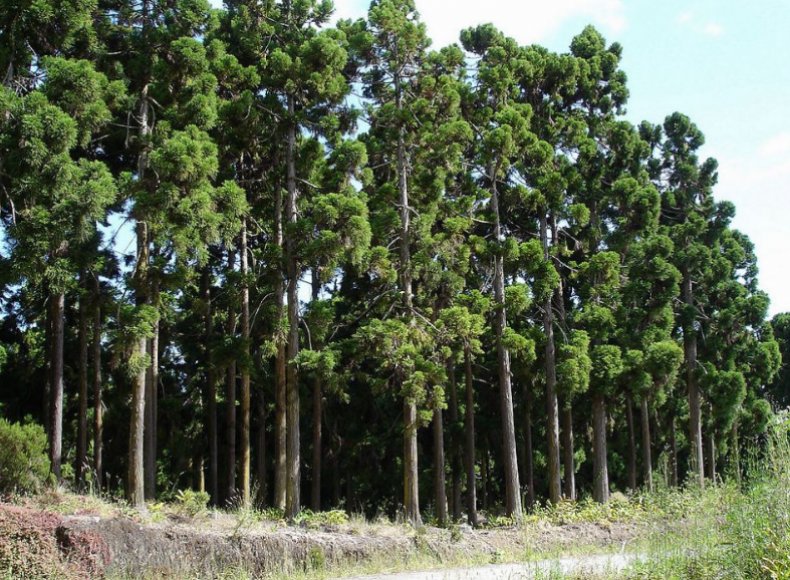 According to the description of wild cryptomeria, it is difficult to imagine this oriental guest in a garden and park design or indoor interior. But thanks to the efforts of botanists, many decorative forms have been bred that do not exceed two meters in height and look great in single and composite plantings. In addition, the needles of some species acquire yellowish and purple tones for the winter. The needles are not prickly to the touch, subulate and not long. Fruits are small, roundish, brown in color. Their ripening period does not exceed one year.
According to the description of wild cryptomeria, it is difficult to imagine this oriental guest in a garden and park design or indoor interior. But thanks to the efforts of botanists, many decorative forms have been bred that do not exceed two meters in height and look great in single and composite plantings. In addition, the needles of some species acquire yellowish and purple tones for the winter. The needles are not prickly to the touch, subulate and not long. Fruits are small, roundish, brown in color. Their ripening period does not exceed one year.
Scientists identify cryptomeria as a unique species and cultivate a variety of decorative varieties of this tree. The dwarf forms Vilmoriniana, Vandai-sugi, Araucarioides and the globular Еlegans compacta, Сompressa, Dacrydioides, Globosa are especially popular. Some varieties have golden or smoky blue foliage.

How to choose garden lighting for cryptomeria
The tree is comfortable in warm, protected from strong winds and drafts. Japanese Cryptomeria prefers well-lit places, but is afraid of direct sunlight. It can easily adapt to the shadow, which will not be reflected at all on its decorative effect. The culture does not like low temperatures, in summer it is comfortable at 22-25 ºС, and in winter - at +12 ºС. Therefore, the plant is often grown in pots, which are placed in the garden on semi-shady lawns in the hot season and left for the winter until severe frosts. If the tree is not sheltered from the cold, it will disappear.
Growing soil
Cryptomeria in the garden grows well on fresh, deep and loose substrates. In addition, they must be well-drained, since the tree cannot tolerate stagnant moisture. Also, you can not start planting in places with a close location of groundwater and on limestone. Sourish moist soils are ideal for the eastern "herringbone".


